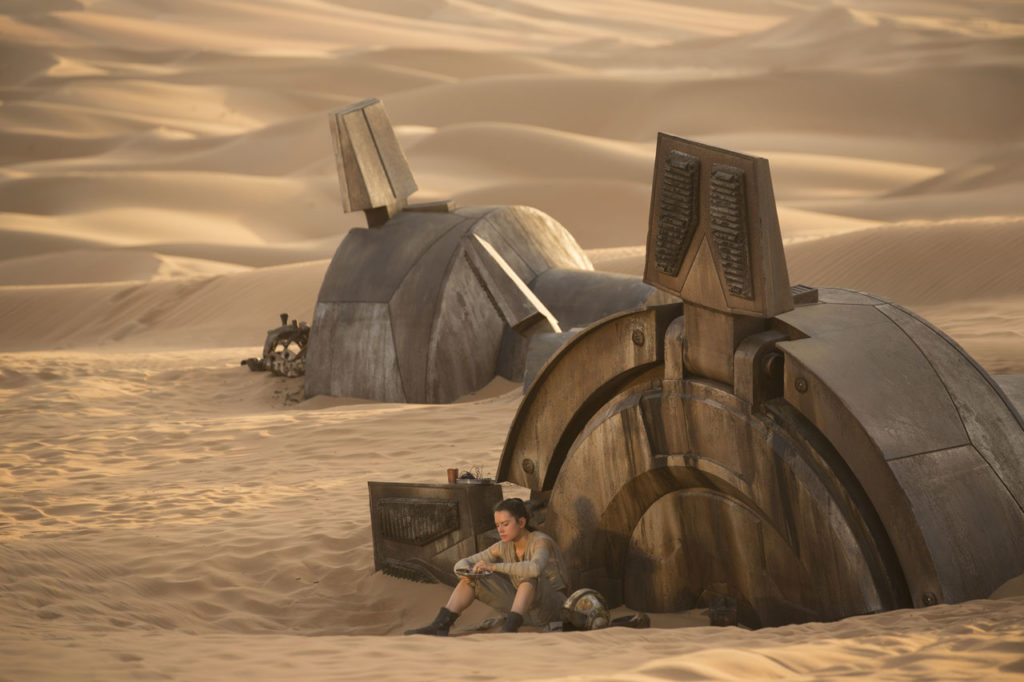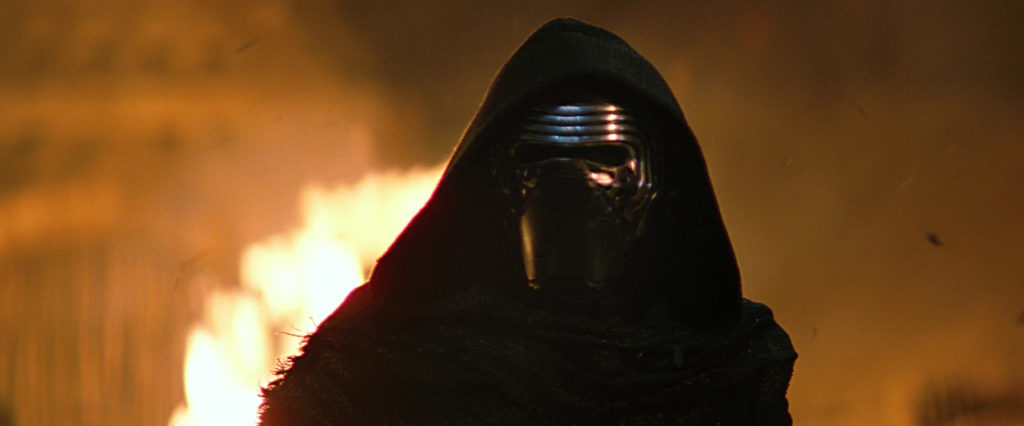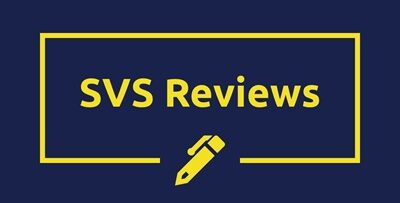This post was originally published January 3, 2016 on our parent site ForgetTheBox.net. We are re-publishing it here, along with a few other reviews, to help get this site going.
Also there are SPOILERS!
I won’t mince words. I loved The Force Awakens. I was excited to see it and excited while watching it. The look and feel, the pacing, everything fell nicely into place. Nostalgia was littered all over Jakku, the first planet we visit, in the form of Rebel Alliance and Imperial wreckage.
Such an homage to the original trilogy could be one of the reasons Star Wars creator George Lucas decided to call the new film Retro Star Wars in an interview with Charlie Rose, the same interview where he referred to Disney as “white slavers,” a comment he has since tried to backtrack. While Lucas’ comments were probably largely due to Disney and Abrams not bringing him on as a consultant, his retro claim could be justified by similarities between Episode VII and 1977’s Episode IV: A New Hope.
Sure, some of the story elements found in the first Star Wars film are mirrored in this Abrams continuation. When Han Solo (Harrison Ford) stepped onto that bridge with everyone watching, I was instantly reminded of the fateful Obi Wan/Darth Vader battle in the Death Star and knew that Kylo Ren (Adam Driver) wasn’t going to turn to the light side, but rather give the audience a reason to hate him.
But this film isn’t A New Hope, it’s the continuation of a story that hasn’t progressed in any kind of cinematic form in 32 years. The prequels, The Clone Wars TV show and now Star Wars: Rebels all have something to offer to the Star Wars universe, but what they offer is filling in the blanks of the backstory. This is new.
The main difference between The Force Awakens and A New Hope, though, is the strength of its lead character.
Rey is Not Luke
Daisy Ridley’s Rey is a Star Wars lead like no other. Sure, she is clearly on a Luke Skywalker-type story arc: unlikely hero from a desert planet with mysterious parentage discovers a droid with plans that can alter the fate of the galaxy and sets out on a wild adventure.
But she isn’t Luke. If you take off the blinders of nostalgia and childhood, you realize that Luke started off as a kind of annoying character.
Now, keep in mind, this is coming from someone who grew up on the original trilogy, was released the same year as the first movie, owned a Millenium Falcon playset, a Han Solo action figure which was lost in the water near a summer camp, a Yoda Magic 8-Ball which tells you if you can be a Jedi (and currently has one ear missing), a comic book adaptation of A New Hope and the Star Wars ABCs (“A is for AT-AT”).
I’m not blaming Mark Hamill and was excited to see him again, albeit briefly, in this film. It’s how George Lucas wrote and initially directed Luke that makes him kind of a brat. A kid who has a relatively comfortable, though boring, life, wants something more. He’d love to save the galaxy, just as long as his uncle doesn’t ground him.

It’s like a suburban teenage escape fantasy meets classic Greek hero myth. Yes, I know Luke’s a moisture farmer, but his goal of joining the rebellion seems to stem, at first, from a desire to get to the big city more than anything else. Yes, he grows up, changes and is ready for the challenge at the right time, but that is with a lot of help from Obi Wan, circumstance and later Yoda.
Rey, on the other hand, comes from nothing (or comes from Luke, Obi-Wan, Han and Leia or the Force itself, depending on which theory you subscribe to) and has nothing. She’s a scavenger, making her own way in the galaxy, surviving with few comforts.
Her home is a downed Imperial AT-AT. While the brief overhead shot establishing that fact also happens to be one of the coolest nods to Original Trilogy nostalgia in the film, it also really lets us know how self-reliant Rey is.
A Quicker Learner
Some critics have objected to the ease and quickness with which Rey adapted to her Force abilities and the fact that she didn’t have any training, a few even resorted to calling her a Mary Sue. Perhaps inspired by sexism or desire to keep the original trilogy sacrosanct, these critics ignored the obvious: Rey’s hastened grasp of her Force abilities makes logical sense and makes sense within the Star Wars Universe
Someone who grew up in a family structure as Luke did may need guidance to unlock his Jedi powers. Someone who was plucked from slavery early and raised in a rather elite environment like Anakin was may take more time, which was available to him, to hone his skills. Someone who has always had to improvise and think and survive on their own as Rey has may be able to pick things up, including how to use the Force, a little bit quicker than the rest.
She also comes across as one of the most real characters the Star Wars universe has produced. When she arrives on Takodana and comments that it is the most green she has ever seen, you really believe her. It could be Ridley’s acting, Abrams’ direction, the Abrams/Laurence Kasandan writing or a combination of the three, but you really feel for her.
It is also clear that she wants to do what is right because of something inside her. Yes, she initially rejected the Skywalker lightsaber, but if you touched some piece of metal in a hidden chest and started having freaky visions, wouldn’t you want to get far away from it, too?
Friends and Foes
Rey’s credibility and likeability as a lead is only bolstered by the other characters in the movie, friend or foe.
Finn (John Boyega) is also a unique Star Wars hero. While his ability with a blaster and the fact that he left one way of life for another may be similar to Han Solo’s path, not to mention that they’re setting him up to be Rey’s love interest, he isn’t Solo.
Solo reluctantly shifted from smuggling to heroics after some prodding. Finn went from being a mindless servant of the dark side to helping save the day on his own because he felt what the New Order was doing was wrong.

Han and Leia (Carrie Fisher) were Han and Leia, just 30 years and a huge problem with their son later. The course their relationship took made sense and you could still feel the love the characters had for each other long after the fairytale destruction of the second Death Star had faded.
On the dark side of things, Kylo Ren was cartoonishly menacing with the mask on and something akin to Hayden Chrisensen’s Anakin with it off. Have a look at the Emo Kylo Ren parody Twitter account if you haven’t already done so.
While the Supreme Leader Snoke will probably train him better in the next film, his lack of ability only helped the credibility of what happened this time out. A first-time, untrained lightsaber wielder like Rey couldn’t stalemate Vader, but she could, logically, fight this version of Kylo Ren to a draw.
Just the Right Balance
While it may be a little odd to praise the realistic in a film with spaceships, invisible powers, alien superweapons and Wookies, that’s exactly what JJ Abrams found. Among all the strange creatures, special effects and sci-fi fantasy, we get very believable and relatable characters in rather logical relationships to each other.
This isn’t A New Hope, but it sure as hell is Star Wars. A Star Wars that George Lucas inspired but didn’t create. He shouldn’t complain. The prequel trilogy may have been the movies Lucas wishes he could have made back in the late 70s and early 80s but lacked the technology to do so, but they also lacked the spirit of the Original Trilogy.
JJ Abrams found that spirit and built on it. I guess you could say he found balance in the Force, using just the right amount of CGI and the right amount of real world sets and props. Most important, though, he abandoned the wooden acting style and dialogue of the prequels and opted instead for real characters. In the process, he created a whole new type of Star Wars hero.
